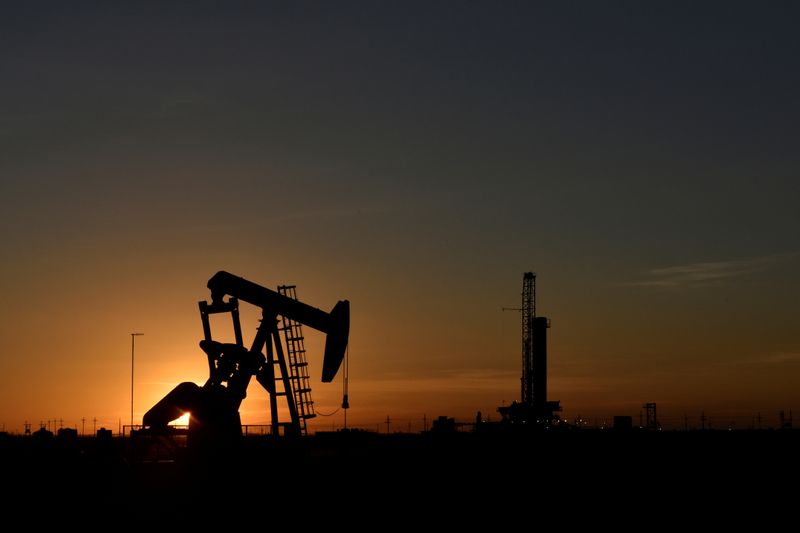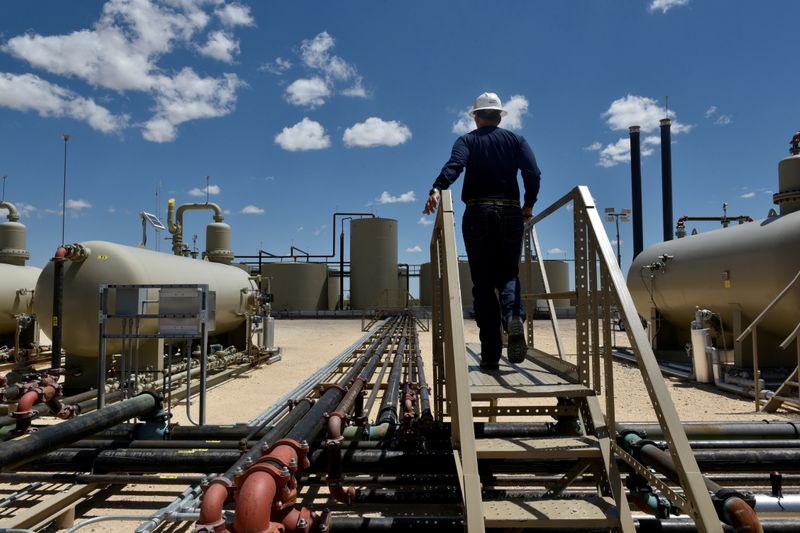By Jennifer Hiller and Devika Krishna Kumar
HOUSTON/NEW YORK (Reuters) - A reopening of some major economies locked down due to the coronavirus has lifted global oil prices and encouraged U.S. shale producers to return at least a third of the 2 million barrels per day (bpd) curtailed since April.
But that bump in output is unlikely to be sustained as shale wells lose up to half their initial output after the first year, and require constant drilling to maintain and increase production.
With most new drilling halted and OPEC relaxing curbs that have underpinned the oil-price recovery, shale output will slide again in autumn, said oil executives and analysts.
Shale output falls off faster than at conventional oil wells, a factor that will lead to output declining by September.
Average U.S. daily oil output will fall below 2019's record 12.2 million barrels per day (bpd) for the next two to three years, analysts said.
The decline means further economic damage from an industry that contributed nearly 1 percentage point to U.S. GDP early last decade. U.S. pipeline and oil export-terminal projects have been delayed or canceled as shale production forecasts have been cut.
"You shut down like this, reduce activity like this, and it is going to be felt for a while," David Dell'Osso, chief operating officer of shale producer Parsley Energy (N:PE) said in an interview.
Graphic: A slowdown in U.S. shale - https://fingfx.thomsonreuters.com/gfx/editorcharts/ygdpzwoyqvw/index.html
LAG EFFECT
Parsley Energy's plans mirror that of many shale rivals that have begun reopening existing wells but tightly restricting new activity. It had planned to operate 15 drilling rigs this year, but halted work in the spring as oil demand shrank on pandemic-related business closings.
This month, the company restarted drilling with two rigs, not enough to maintain existing production levels. Keeping output flat would take four to five rigs, which it may edge toward later this year, Dell'Osso said.
Diamondback Energy (O:FANG), one of the top U.S. shale producers, reopened most of its curtailed wells this month. It expects to pump about 180,000 bpd this year, down from 188,000 bpd last year. The reason: its rig count fell from 20 at the end of March to just seven by mid July, and is expected to be six by the end of the month.
Much of the shale production curtailments came from shale wells that were choked back but not shut-in completely, several shale company executives said.
The Organization of the Petroleum Exporting Countries and its allies' decision to return 2 million bpd to global markets beginning next month will likely keep a lid on prices and leave less room for shale. The group known as OPEC+ agreed to production cuts of 7.7 million bpd through December.
However, OPEC+ cautioned that a second wave of COVID-19 infections could halt its plan to further ease constraints next year, officials said. The cuts since May have more than doubled benchmark Brent crude (LCOc1) to about $44 a barrel, from $20 in April.
OPEC's ability to add more oil to global markets "is why we’re not reactivating at nearly the level before," Parsley's Dell'Osso said.
SPENDING ON NEW WELLS
This year's oil price collapse led the 25 largest public U.S. producers to cut capital spending plans by 47%, and idle more than 75% of U.S. drilling rigs since last year, according to data firm Enverus.
As rig counts continue to slide to all-time lows, a return to record high levels of output is likely to take years due to the sharp, natural decline rates of shale wells. Some analysts refer to it as the treadmill effect, meaning producers must keep drilling just to remain in place.
"If you don't continue to bring new wells onstream, you will fly off the back of this treadmill," said Raoul LeBlanc, vice president for North American unconventionals at data provider IHS Markit.
In June, just 155 rigs were working in the top four shale basins, and so far in July, that number is down to 145, said petroleum geologist and consultant Art Berman.
"That is well below the approximately 600 required to sustain production from those fields at the 2019 average level of 6.8 million bpd, which corresponds to 12.2 million bpd average U.S. crude + condensate production in 2019," Berman said.
The outlook for new drilling, even with oil prices now double that of April, remains bleak with oilfield companies slashing their staff and budgets. This month, BJ Services and Hi-Crush, two of the largest fracking and frac-sand suppliers, filed for protection from creditors.
In Texas, new drilling permits fell 69% in June from a year earlier. North Dakota last month reported 405,000 bpd of production shut-ins. Wyoming, the eighth-largest U.S. oil producing state, in late June reported no rigs at work, the first time since at least 1992.
"No one is going to have the staff or the rigs over the next year to increase production," said Ryan Sitton, commissioner with Texas's oil and gas regulator. "We've never had this few rigs running."
Outside of shale fields, U.S. oil output also has dropped as higher-cost, older wells shut. An estimated 200,000 bpd from these so-called stripper wells was halted as prices crashed and an undetermined amount will never return to production, said analysts.
These aging wells are costly to maintain and face technical challenges to resume production, unlike shale wells which have little impact by being curtailed for short periods, said Bernadette Johnson, vice president at data firm Enverus.

"The shut-ins have been dramatic, and some may be permanent," said Patrick Montalban, a Montana producer and treasurer of the National Stripper Well Association, which represents owners of these aged wells.
